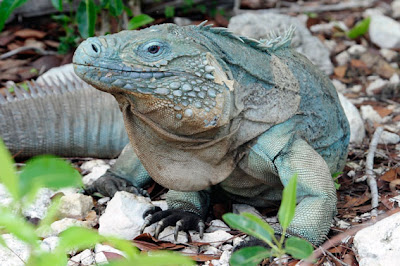Animal Unique | Blue Iguana | The Blue Iguana or Grand Cayman Iguana is a critically endangered species of lizard of the genus Cyclura endemic to the island of Grand Cayman. The Blue Iguana prefers to live in rocky, sunny, open areas in dry forests or near the coast, as the females must dig holes in the sand to lay eggs in June and July. Their species name, lewisi, comes from the naturalist who first wrote about them, Bernard C. Lewis. Even back in 1938, Lewis understood their rarity, saying that he doubted more than a dozen, also lived on the island. Blue Iguanas live naturally in only one location, Grand Cayman, a 76 square mile island in the Caribbean Sea. These iguanas are also one of the longest living species of lizard, with the oldest on record to die at age 69.
Scientific classification
Kingdom: Animalia
Phylum: Chordata
Class: Reptilia
Order: Squamata
Family: Iguanidae
Genus: Cyclura
Species: C. lewisi
Kingdom: Animalia
Phylum: Chordata
Class: Reptilia
Order: Squamata
Family: Iguanidae
Genus: Cyclura
Species: C. lewisi
The Blue Iguana is a large iguana with a total nose-to-tail length of 1.5 m and a weight of less than 14 kg. Its body length is 51-76 cm with a tail equal in length. The Blue Iguana's toes are articulated to be effective in digging and climbing trees. The male is larger than the female, one third of its body weight. The adult male skin color ranges from dark blue to turquoise, while the female is more olive green to light blue. Young animals are usually uniformly dark brown or green with faint dark stripes. The adult Blue Iguana is generally dark gray corresponds to the limestone rock of the landscape. The animal changes color to blue when in the presence of other iguanas to give up territory. The blue color is more pronounced in the males of the species. Their distinctive black feet, unlike their lighter body color. Male Blue Iguanas have distinctive femoral pores, which are used to release pheromones.
The Blue Iguana's eyes a golden iris and red sclera. They have excellent vision, which allows them to detect shapes and movements over the long haul. As Blue Iguanas have only a few rod cells, they have poor visibility in low light. Simultaneously, they have cells called "double cones" them sharp color vision and enable them to see ultraviolet wavelengths. Blue Iguanas have developed a sensory organ white photo on the top of their heads called the parietal eye. This "eye" in the same way as a normal eye work as only a rudimentary retina and lens, and therefore can not images. However, it is sensitive to changes in light and dark and can detect motion.
Like most iguanas, Blue Iguanas are herbivores. The Blue Iguana is primarily herbivorous, consuming leaves, flowers and fruits from more than 45 species of plants. This diet is very rarely supplemented with insect larvae, crabs, snails, dead birds and fungi. Studies show that their diet 45 different plant species, of which 80% of their total consumption of leaves, and the remaining 20% fruit brings. These iguanas are solitary animals, with females guarding an area and the men switch between multiple locations. During the breeding season, males try and expand their product range includes as many female territories as possible. Females stop eating to make room for the eggs they lay 20ish. Iguanas, like most reptiles, do not help in raising their young.
Like most iguanas, Blue Iguanas are herbivores. The Blue Iguana is primarily herbivorous, consuming leaves, flowers and fruits from more than 45 species of plants. This diet is very rarely supplemented with insect larvae, crabs, snails, dead birds and fungi. Studies show that their diet 45 different plant species, of which 80% of their total consumption of leaves, and the remaining 20% fruit brings. These iguanas are solitary animals, with females guarding an area and the men switch between multiple locations. During the breeding season, males try and expand their product range includes as many female territories as possible. Females stop eating to make room for the eggs they lay 20ish. Iguanas, like most reptiles, do not help in raising their young.
With support from Durrell and other international partners, the Blue Iguana Recovery Program successfully breeding the iguanas in captivity since 1990, and began the reintroduction of wildlife. The recovery plan for the Blue Iguana seeks at least a thousand people tried to restore the protected areas.Blue Iguanas have suffered tremendously from the clearing of the land that once supplied their needs - a relatively low open vegetation that sufficient light and warmth (canopy casts too much shade), enough native vegetation to a continuous food supply, rocks provide shelter and soil to nest in.
Habitat destruction is the main factor threatening imminent extinction for this iguana. Grubbing within remnant habitat occurs in agriculture, road construction, and real estate development and speculation. Conversion of traditional crops, pasture land for cattle is also eliminating secondary Blue Iguana habitat. Predation by rats and injury to young, to young and sub-adults by feral cats and dogs roaming by killing adults are all placing great pressure on the remaining wild population. Education programs have been the people of the Cayman Islands very proud of their largest native animal, and help reduce confusion with the common green iguana, which was introduced to the islands. The captive breeding project aims 80 animals after one year and more protected areas are established to keep the growing population.
Animal Unique






Tidak ada komentar:
Posting Komentar